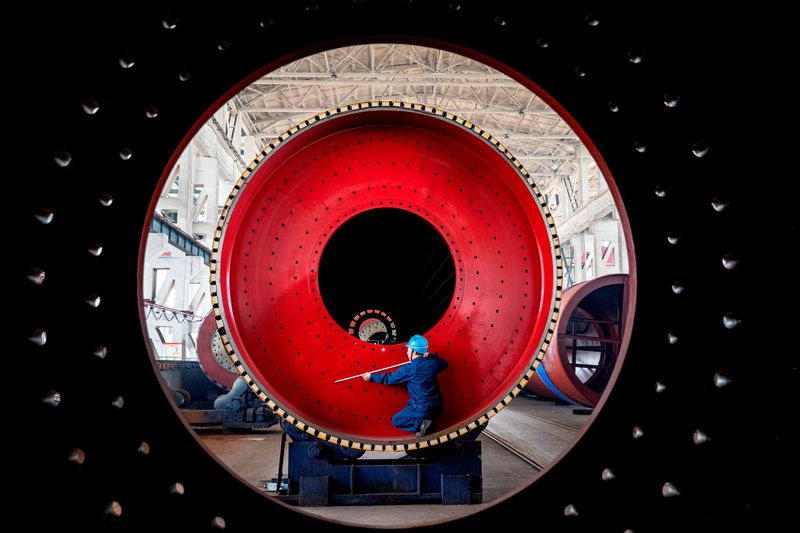China’s June factory activity expands at fastest pace in 13 months – Caixin PMI
2022.07.01 05:06

FILE PHOTO: An employee measures a newly manufactured ball mill machine at a factory in Nantong, Jiangsu province, China June 28, 2019. Picture taken through a ball mill machine June 28, 2019. REUTERS/Stringer
BEIJING (Reuters) – China’s manufacturing activity expanded at its fastest in 13 months in June, buoyed by a strong rebound in output, as the lifting of COVID lockdowns sent factories racing to meet recovering demand, a private sector poll showed on Friday.
The Caixin/Markit manufacturing purchasing managers’ index (PMI) rose to 51.7 in June, also indicating the first expansion in four months, from 48.1 in the previous month. That was well above analysts’ expectations for an up-tick to 50.1.
The 50-point index mark separates growth from contraction on a monthly basis.
The recovery suggested in the Caixin survey, which focused on more export-oriented and small firms in coastal regions, was more convincing compared with findings in an official survey.
Economic activity has sped up in June since various COVID lockdowns have been rolled back as COVID-19 cases fell, with a range of support measures unveiled by the State Council in late May to stabilise growth gradually kicking in.
A sub-index for output bounced to the highest level since November 2020, while new orders, bolstered by the first increase in export orders in about a year, snapped three months of decline and posted the fastest growth in four months.
Delivery times for suppliers stabilised in June amid easing supply chain snags, after worsening for the past two years.
However, despite the strong rebound, factories remained cautious in terms of hiring more staff, with employment falling for the third month in a row.
“Restoration in the post-pandemic era remained the focus of the current economy, yet its base was far from strong,” said Wang Zhe, senior economist at Caixin Insight Group.
“Deteriorating household income and expectations caused by a weak labor market dampened the demand recovery. Correspondingly, supportive policies should target employees, gig workers and low-income groups impacted by the outbreaks.”
China’s economy has started to chart a recovery path out of the supply shocks caused by strict lockdowns, but headwinds persist, including record high jobless rate in big cities, a still subdued property market, soft consumer spending and fear of any recurring waves of infections.
Analysts expect further improvement in economic conditions in the third quarter, although the official GDP target of around 5.5% for this year will be hard to achieve unless the government abandons the zero-COVID strategy.
President Xi Jinping defended the zero-COVID policy on Tuesday, saying China is willing to accept some temporary impact on economic development over harm to people’s health.








